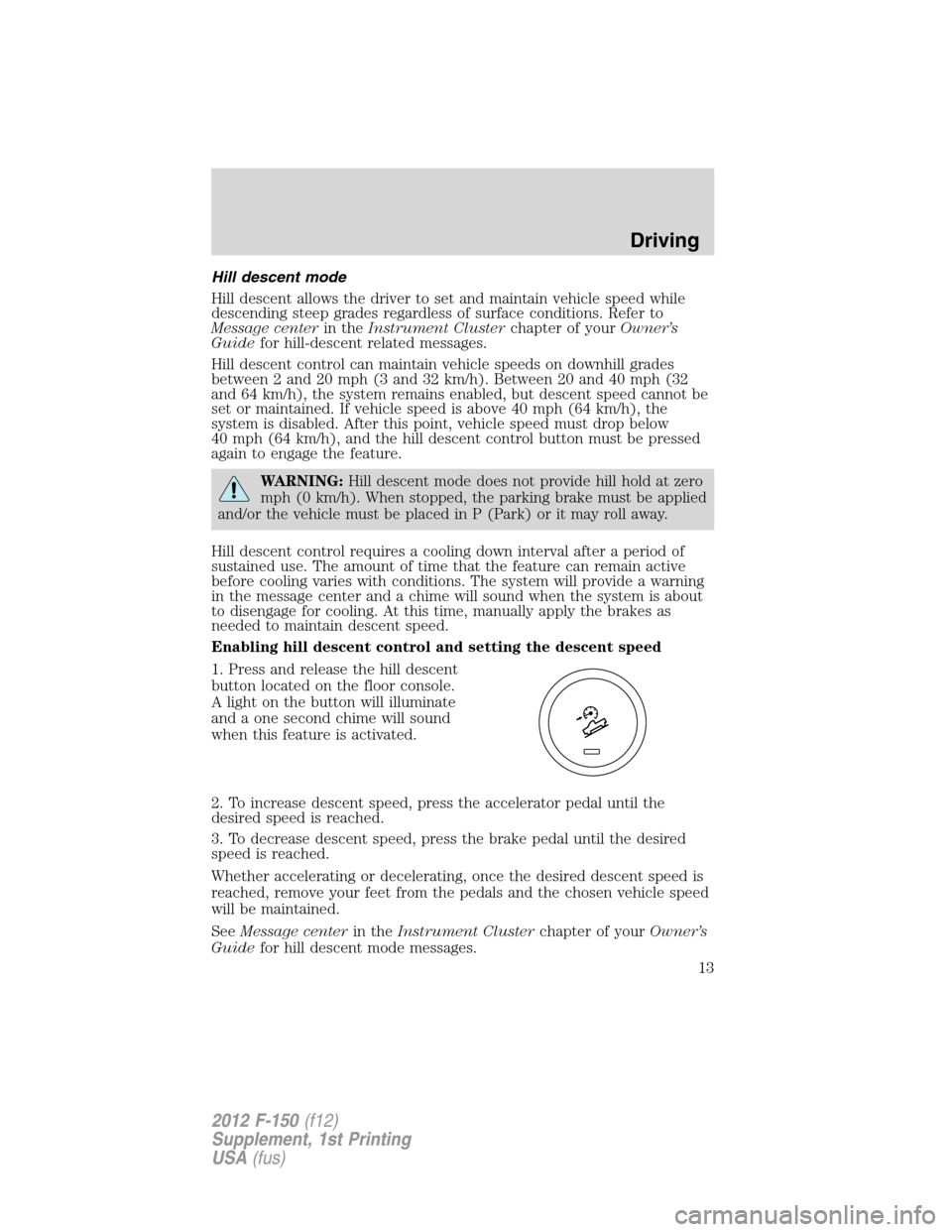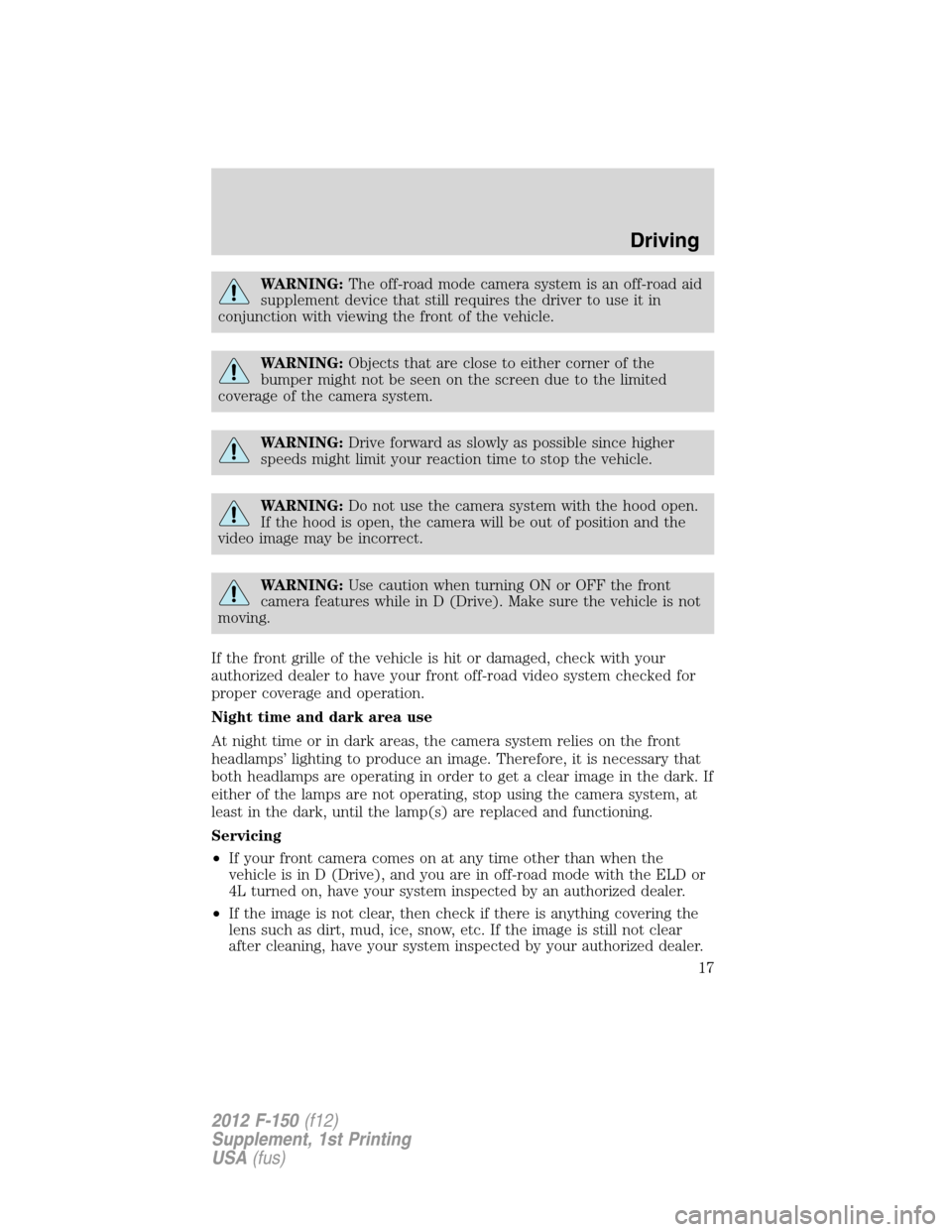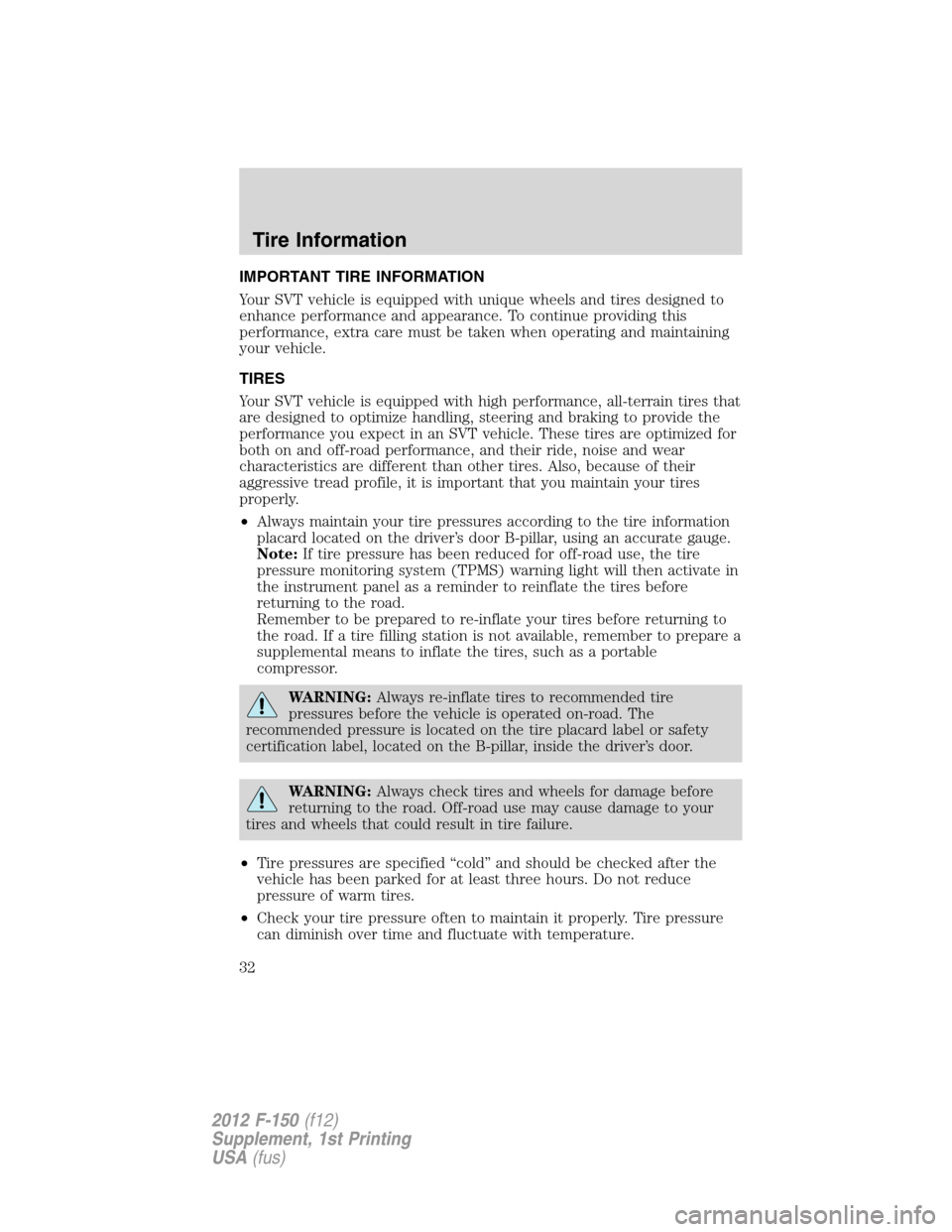2012 FORD F150 warning light
[x] Cancel search: warning lightPage 13 of 36

Hill descent mode
Hill descent allows the driver to set and maintain vehicle speed while
descending steep grades regardless of surface conditions. Refer to
Message centerin theInstrument Clusterchapter of yourOwner’s
Guidefor hill-descent related messages.
Hill descent control can maintain vehicle speeds on downhill grades
between 2 and 20 mph (3 and 32 km/h). Between 20 and 40 mph (32
and 64 km/h), the system remains enabled, but descent speed cannot be
set or maintained. If vehicle speed is above 40 mph (64 km/h), the
system is disabled. After this point, vehicle speed must drop below
40 mph (64 km/h), and the hill descent control button must be pressed
again to engage the feature.
WARNING:Hill descent mode does not provide hill hold at zero
mph (0 km/h). When stopped, the parking brake must be applied
and/or the vehicle must be placed in P (Park) or it may roll away.
Hill descent control requires a cooling down interval after a period of
sustained use. The amount of time that the feature can remain active
before cooling varies with conditions. The system will provide a warning
in the message center and a chime will sound when the system is about
to disengage for cooling. At this time, manually apply the brakes as
needed to maintain descent speed.
Enabling hill descent control and setting the descent speed
1. Press and release the hill descent
button located on the floor console.
A light on the button will illuminate
and a one second chime will sound
when this feature is activated.
2. To increase descent speed, press the accelerator pedal until the
desired speed is reached.
3. To decrease descent speed, press the brake pedal until the desired
speed is reached.
Whether accelerating or decelerating, once the desired descent speed is
reached, remove your feet from the pedals and the chosen vehicle speed
will be maintained.
SeeMessage centerin theInstrument Clusterchapter of yourOwner’s
Guidefor hill descent mode messages.
Driving
13
2012 F-150(f12)
Supplement, 1st Printing
USA(fus)
Page 17 of 36

WARNING:The off-road mode camera system is an off-road aid
supplement device that still requires the driver to use it in
conjunction with viewing the front of the vehicle.
WARNING:Objects that are close to either corner of the
bumper might not be seen on the screen due to the limited
coverage of the camera system.
WARNING:Drive forward as slowly as possible since higher
speeds might limit your reaction time to stop the vehicle.
WARNING:Do not use the camera system with the hood open.
If the hood is open, the camera will be out of position and the
video image may be incorrect.
WARNING:Use caution when turning ON or OFF the front
camera features while in D (Drive). Make sure the vehicle is not
moving.
If the front grille of the vehicle is hit or damaged, check with your
authorized dealer to have your front off-road video system checked for
proper coverage and operation.
Night time and dark area use
At night time or in dark areas, the camera system relies on the front
headlamps’ lighting to produce an image. Therefore, it is necessary that
both headlamps are operating in order to get a clear image in the dark. If
either of the lamps are not operating, stop using the camera system, at
least in the dark, until the lamp(s) are replaced and functioning.
Servicing
•If your front camera comes on at any time other than when the
vehicle is in D (Drive), and you are in off-road mode with the ELD or
4L turned on, have your system inspected by an authorized dealer.
•If the image is not clear, then check if there is anything covering the
lens such as dirt, mud, ice, snow, etc. If the image is still not clear
after cleaning, have your system inspected by your authorized dealer.
Driving
17
2012 F-150(f12)
Supplement, 1st Printing
USA(fus)
Page 20 of 36

•When negotiating low speed obstacles, applying light brake pressure in
conjunction with the throttle will help prevent the vehicle from jerking
and will allow you to negotiate the obstacle in a more controlled
manner. Using 4L will also help with this.
•Use and equip supplemental safety equipment as discussed later in
this chapter.
•Please consult your local off-road group for other helpful tips.
•Off-roading requires a high degree of concentration. Even if your local
law does not prohibit alcohol use while driving off-road, Ford strongly
recommends against drinking if you plan to off-road.
Driving in mud
•Deep mud should be approached with caution especially if you are
driving in an unfamiliar area.
•If possible, test the depth of a mud hole before entering with the
vehicle.
•Keep in mind that obstacles and deep ruts may be hidden beneath the
surface of the mud.
•Proceed in a steady, controlled manner through deep mud while
maintaining momentum.
•If momentum is lost and you feel the vehicle becoming stuck, turning
the steering wheel back and forth (“sawing the wheel”)
1�4turn in
each direction may give the traction you need to clear the muddy
area.
•In higher speed areas with shallow mud, directional control will be
reduced in the muddy area much like on snow or ice. When
approaching such an area, be sure to slow to a speed which allows you
to maneuver as required by the conditions.
Driving in sand
WARNING:Tires must be returned to normal recommended tire
pressures before driving on pavement or hard surfaces. Failure
to properly maintain your tire pressure could increase the risk of tire
failure, loss of control, vehicle rollover and personal injury.
Driving
20
2012 F-150(f12)
Supplement, 1st Printing
USA(fus)
Page 32 of 36

IMPORTANT TIRE INFORMATION
Your SVT vehicle is equipped with unique wheels and tires designed to
enhance performance and appearance. To continue providing this
performance, extra care must be taken when operating and maintaining
your vehicle.
TIRES
Your SVT vehicle is equipped with high performance, all-terrain tires that
are designed to optimize handling, steering and braking to provide the
performance you expect in an SVT vehicle. These tires are optimized for
both on and off-road performance, and their ride, noise and wear
characteristics are different than other tires. Also, because of their
aggressive tread profile, it is important that you maintain your tires
properly.
•Always maintain your tire pressures according to the tire information
placard located on the driver’s door B-pillar, using an accurate gauge.
Note:If tire pressure has been reduced for off-road use, the tire
pressure monitoring system (TPMS) warning light will then activate in
the instrument panel as a reminder to reinflate the tires before
returning to the road.
Remember to be prepared to re-inflate your tires before returning to
the road. If a tire filling station is not available, remember to prepare a
supplemental means to inflate the tires, such as a portable
compressor.
WARNING:Always re-inflate tires to recommended tire
pressures before the vehicle is operated on-road. The
recommended pressure is located on the tire placard label or safety
certification label, located on the B-pillar, inside the driver’s door.
WARNING:Always check tires and wheels for damage before
returning to the road. Off-road use may cause damage to your
tires and wheels that could result in tire failure.
•Tire pressures are specified “cold” and should be checked after the
vehicle has been parked for at least three hours. Do not reduce
pressure of warm tires.
•Check your tire pressure often to maintain it properly. Tire pressure
can diminish over time and fluctuate with temperature.
Tire Information
32
2012 F-150(f12)
Supplement, 1st Printing
USA(fus)